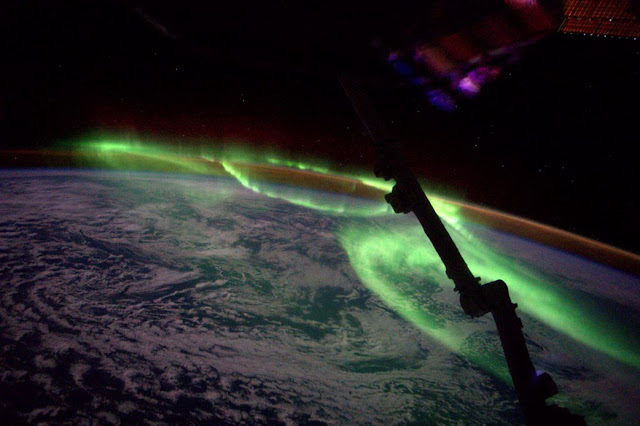mardi 12 juillet 2016
ISS - Weekly Recap From the Expedition Lead Scientist Week of June 27, 2016
ISS - International Space Station logo.
July 12, 2016
Image above: Just past the International Space Station's external robotic arm -- called Canadarm -- NASA astronaut Jeff Williams captured this image of the aurora south of Australia during a recent orbit. He posted it to his Twitter social media account - @Astro_Jeff. Image Credits: NASA/Jeff Williams.
(Highlights: Week of June 27, 2016) - Crew members on the International Space Station re-installed the first 3D printer in orbit to continue research on the developing technology and how it can be used in space.
NASA astronaut Jeff Williams installed the printer in the Microgravity Science Glovebox (MSG) to begin another round of sample builds for NASA's 3D Printing in Zero-G Technology Demonstration. The 3D printer, originally delivered to the station and tested in 2014, heats a relatively low-temperature plastic filament to build parts layer by layer using designs supplied to the machine.
Animation above: A view inside the 3D printer as it prints a test coupon during a recent run inside the Microgravity Science Glovebox. Animation Credit: NASA.
The goal of having the 3-D printer on the orbiting laboratory is to demonstrate that additive manufacturing can be used to make a variety of parts and tools in space, reducing the need to send replacements from Earth. It is the first step toward establishing an on-demand machine shop in space -- a critical component to sustain deep-space crewed missions and in-space manufacturing. These new samples will be returned to Earth for comparison to similar objects manufactured by the printer before it was launched.
Science teams on the ground continued to monitor solar radiation using detectors on the space station as part of the Dose Distribution Inside the International Space Station-3D (DOSIS-3D) investigation.
Image above: NASA astronaut Jeff Williams documents a test coupon printed using the 3D printer aboard the International Space Station. Image Credit: NASA.
Space travelers are continually exposed to varying levels of radiation, which can be harmful to their health. Monitoring solar radiation will be critical to astronauts on long missions to deep space. The DOSIS-3D investigation uses several active and passive detectors to determine the radiation doses. The goal of the European Space Agency (ESA) investigation is creating a three-dimensional radiation map covering all sections of the outpost, documenting the nature and distribution of the radiation field inside the orbiting laboratory.
On Earth, flight crews and nuclear plant workers are exposed to greater-than-average radiation. DOSIS-3D also provides insight into combining different devices for dosage monitoring and lessons in how to monitor real-time data. This could improve radiation monitoring for commercial and military airline crews, as well as other workers exposed to radiation on Earth.
Williams continued the long-standing NASA tradition of using short-wave radio to speak to students while on orbit. He spoke to 300 students at Justus-Knecht Gymnasium in Bruchsal, Germany, as part of the ISS HAM program, also known as Amateur Radio on the International Space Station (ISS Ham Radio (ARISS)). Since the earliest space station expeditions, ISS Ham Radio has allowed groups of students in schools, camps, museums and planetariums to hold a conversation with the people living in space. As the station passes overhead, students have between five and eight minutes to ask crew members 10 to 20 questions.
Image above: NASA astronaut Jeff Williams works with the SPHERES UDP investigation inside the Kibo module. SPHERES UDP provides a necessary technology demonstration to study complex scenarios involved during on-orbit servicing and robotic assembly missions. Image Credit: NASA.
The program provides opportunities to engage and educate students, teachers, parents and other members of the community in science, technology, engineering and math, reaching an international audience. In preparation for their conversation with orbiting crew members, students learn about radio waves, amateur radio and related science topics. They conduct research to prepare their questions, which often discuss science activities in orbit and the career choices that led to a trip to space. In addition to inspiring new generations of space engineers, ISS Ham Radio serves as a backup communications network between the station crew and NASA.
Progress was made on other investigations and facilities this week, including Ex-HAM-Interstellar Carbonaceous Solids along with various other Ex-HAM samples, SPHERES and UBNT.
Human research investigations conducted this week include Dose Tracker and Habitability.
Related links:
NASA's 3D Printing in Zero-G Technology Demonstration: http://www.nasa.gov/mission_pages/station/research/experiments/1115.html
International Space Station-3D (DOSIS-3D) investigation: http://www.nasa.gov/mission_pages/station/research/experiments/184.html
Amateur Radio on the International Space Station (ISS Ham Radio (ARISS): http://www.nasa.gov/mission_pages/station/research/experiments/346.html
Ex-HAM-Interstellar Carbonaceous Solids: http://www.nasa.gov/mission_pages/station/research/experiments/2052.html
SPHERES: http://www.nasa.gov/mission_pages/station/research/experiments/311.html
UBNT: http://www.nasa.gov/mission_pages/station/research/experiments/987.html
Dose Tracker: http://www.nasa.gov/mission_pages/station/research/experiments/1933.html
Habitability: http://www.nasa.gov/mission_pages/station/research/experiments/1772.html
European Space Agency (ESA): http://www.esa.int/
International Space Station (ISS): https://www.nasa.gov/mission_pages/station/main/index.html
Space Station Research and Technology: https://www.nasa.gov/mission_pages/station/research/index.html
Images (mentioned), Animation (mentioned), Text, Credits: NASA/Kristine Rainey/John Love, Acting Lead Increment Scientist Expeditions 47 & 48.
Best regards, Orbiter.ch





